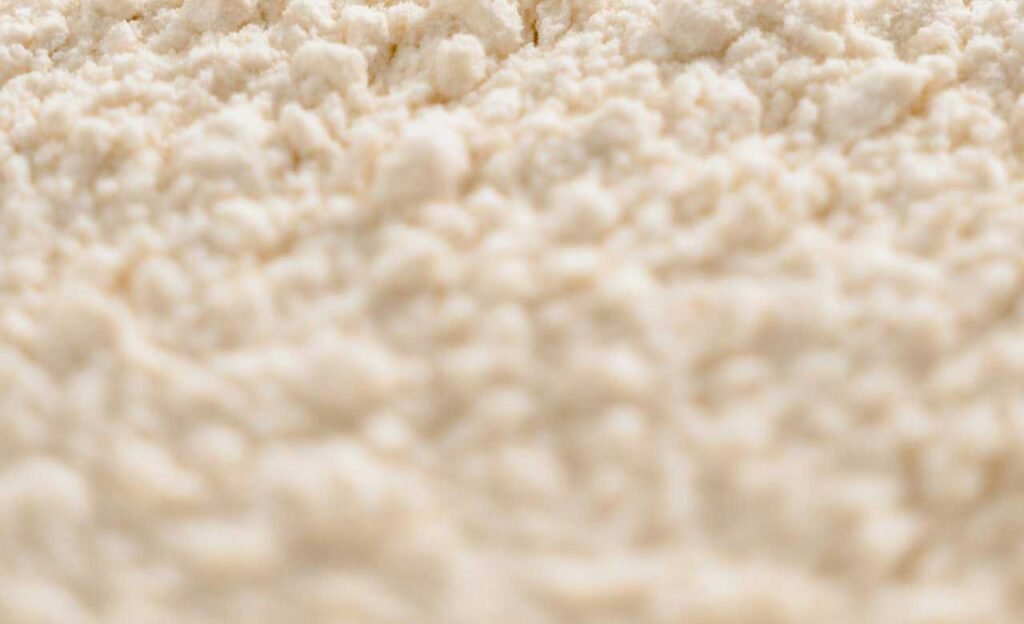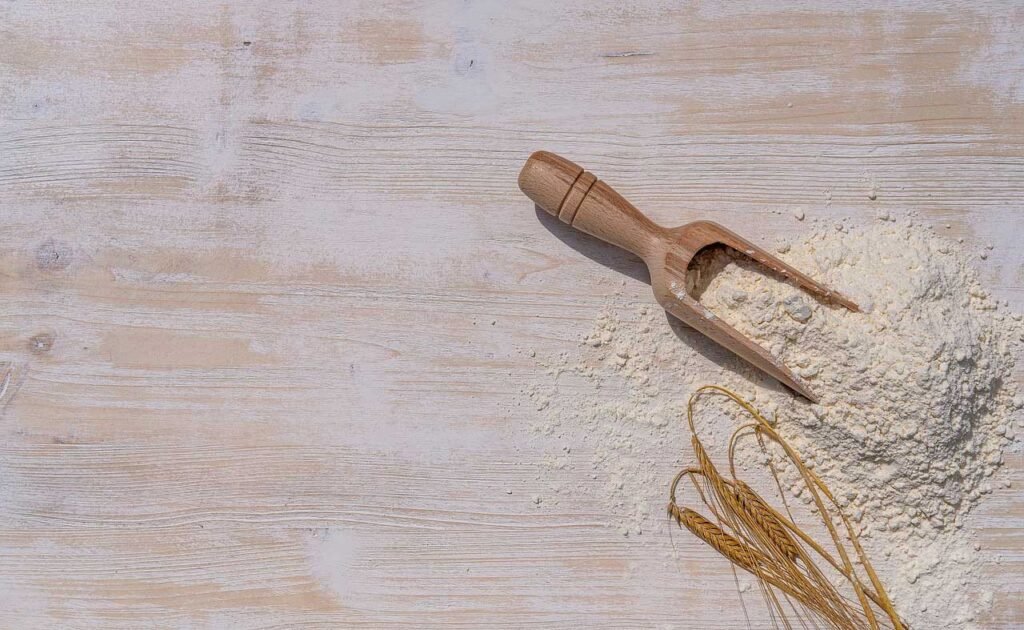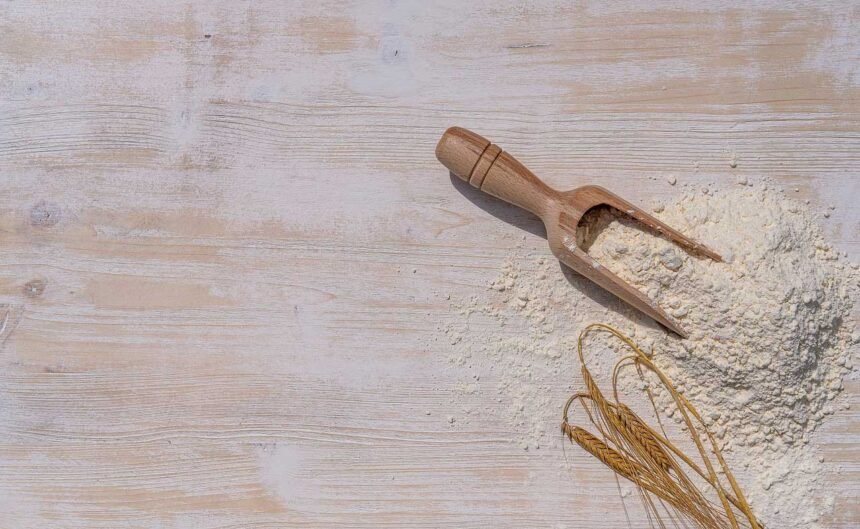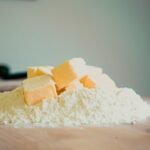Whole wheat flour is a nutritious and versatile ingredient that can transform your baking into a healthier endeavour. This beginner’s guide will walk you through everything you need to know about whole wheat flour, from its nutritional benefits to practical tips for using it in your favourite recipes.
What is Whole Wheat Flour?
Whole wheat flour is a type of flour made by grinding entire wheat kernels, including the bran, germ, and endosperm. Unlike refined white flour, which only uses the endosperm, whole wheat flour retains all the nutritional components of the wheat grain. This results in a flour that’s not only more flavourful but also packed with essential nutrients.
The process of making whole wheat flour begins with cleaning the wheat kernels to remove any debris. The cleaned kernels are then ground into a fine powder using either stone mills or modern steel roller mills. The resulting flour has a slightly coarser texture and a nutty, robust flavour compared to white flour.
One of the key differences between whole wheat flour and white flour is the presence of bran and germ. The bran is the outer layer of the wheat kernel and is rich in fibre, vitamins, and minerals. The germ is the nutrient-dense embryo of the wheat kernel, containing healthy fats, vitamins, and antioxidants. By including these components, whole wheat flour offers a more complete nutritional profile.
It’s worth noting that there are different types of whole wheat flour available in the market:
- Traditional whole wheat flour: Made from red wheat, this flour has a stronger flavour and darker colour.
- White whole wheat flour: Made from white wheat, this flour has a milder flavour and lighter colour but offers the same nutritional benefits.
- Sprouted whole wheat flour: Made from wheat that has been allowed to sprout before milling, potentially increasing nutrient availability.
When shopping for whole wheat flour, always look for labels that specify “100% whole wheat” to ensure you’re getting the full nutritional benefits. Some products labeled as “wheat flour” may actually be mostly refined white flour with only a small percentage of whole wheat added.
Understanding the nature of whole wheat flour is crucial for successful baking. Its higher protein content and the presence of bran can affect the texture and rise of baked goods. However, with the right techniques and recipes, you can create delicious, healthier versions of your favourite baked treats using whole wheat flour.
As we delve deeper into this guide, we’ll explore the nutritional benefits of whole wheat flour, how to use it in your baking, and tips for achieving the best results. Whether you’re looking to boost the nutritional value of your baked goods or simply want to experiment with new flavours, whole wheat flour offers a world of possibilities for healthier baking.
Nutritional Benefits of Whole Wheat Flour
Whole wheat flour stands out as a nutritional powerhouse compared to refined white flour. Its comprehensive nutrient profile makes it an excellent choice for those looking to enhance the health benefits of their baked goods. Let’s explore the key nutritional advantages of incorporating whole wheat flour into your baking repertoire.
Fibre Content
One of the most significant nutritional benefits of whole wheat flour is its high fibre content. A 100-gram serving of whole wheat flour contains approximately 10-12 grams of dietary fibre, which is significantly more than the 2-3 grams found in the same amount of white flour. This high fibre content offers several health benefits:
- Improved digestive health: The fibre in whole wheat flour promotes regular bowel movements and helps prevent constipation.
- Better blood sugar control: Fibre slows down the absorption of sugar, helping to stabilise blood glucose levels.
- Increased satiety: High-fibre foods help you feel full for longer, potentially aiding in weight management.
- Lower cholesterol: Soluble fibre in whole wheat can help reduce LDL (bad) cholesterol levels.
Vitamin and Mineral Content
Whole wheat flour is rich in various essential vitamins and minerals:
- B vitamins: Whole wheat flour is an excellent source of B vitamins, including thiamin, riboflavin, niacin, and folate. These vitamins play crucial roles in energy metabolism and nervous system function.
- Iron: Whole wheat flour contains significantly more iron than white flour, supporting healthy blood cell production and oxygen transport in the body.
- Magnesium: This mineral is important for bone health, muscle and nerve function, and energy production.
- Zinc: Essential for immune function and wound healing, zinc is more abundant in whole wheat flour than in refined flour.
- Vitamin E: An antioxidant that supports immune function and skin health.
Protein Content
Whole wheat flour typically contains more protein than white flour. While the exact amount can vary, whole wheat flour generally has about 13-14 grams of protein per 100 grams, compared to 10-12 grams in white flour. This higher protein content can be beneficial for:
- Muscle maintenance and growth
- Increased satiety
- Improved texture in baked goods
Phytonutrients
Whole wheat flour contains various phytonutrients, which are plant compounds that offer health benefits:
- Lignans: These compounds have antioxidant properties and may help reduce the risk of certain cancers.
- Phenolic acids: Another group of antioxidants that may help protect against chronic diseases.
Lower Glycemic Index
Baked goods made with whole wheat flour generally have a lower glycemic index compared to those made with white flour. This means they cause a slower and more gradual rise in blood sugar levels, which can be beneficial for managing diabetes and maintaining stable energy levels.

Comparison Table: Whole Wheat Flour vs. White Flour
| Nutrient (per 100g) | Whole Wheat Flour | White Flour |
|---|---|---|
| Calories | 340 | 364 |
| Protein | 13.2g | 10.3g |
| Fibre | 10.7g | 2.7g |
| Iron | 3.9mg | 1.2mg |
| Magnesium | 138mg | 22mg |
| Vitamin B1 (Thiamin) | 0.4mg | 0.1mg |
| Vitamin E | 1.2mg | 0.1mg |
It’s important to note that while whole wheat flour offers numerous nutritional benefits, it should still be consumed as part of a balanced diet. The calorie content of whole wheat flour is similar to that of white flour, so portion control remains important.
By understanding the nutritional benefits of whole wheat flour, you can make informed decisions about incorporating it into your baking. Whether you’re looking to boost your fibre intake, increase your consumption of essential vitamins and minerals, or simply add more variety to your diet, whole wheat flour offers a nutritious alternative to refined flour. In the next section, we’ll explore how to start using whole wheat flour in your baking, helping you make the most of these nutritional advantages.
Getting Started with Whole Wheat Flour in Baking
Incorporating whole wheat flour into your baking routine can be an exciting journey towards healthier and more flavourful baked goods. However, it’s important to understand that whole wheat flour behaves differently from white flour in recipes. Here’s how to get started with whole wheat flour in your baking adventures:
Understanding Whole Wheat Flour’s Properties
Before diving into baking with whole wheat flour, it’s crucial to understand its unique properties:
- Absorption: Whole wheat flour absorbs more liquid than white flour due to its higher fibre content. You may need to adjust the liquid in your recipes accordingly.
- Gluten development: While whole wheat flour contains gluten, the presence of bran can interfere with gluten development, potentially resulting in denser baked goods.
- Flavour: Whole wheat flour has a nuttier, more robust flavour compared to white flour. This can enhance the taste of your baked goods but may also be noticeable in delicate recipes.
- Colour: Baked goods made with whole wheat flour will have a darker colour than those made with white flour.
Starting with Partial Substitution
If you’re new to baking with whole wheat flour, it’s best to start by partially substituting it for white flour in your favourite recipes. Here’s a simple approach:
- Begin by replacing 25% of the white flour with whole wheat flour.
- Observe the results in terms of texture, flavour, and rise.
- Gradually increase the proportion of whole wheat flour in subsequent batches until you find the right balance for your taste preferences.
Adjusting Liquid Content
Due to whole wheat flour’s higher absorption rate, you may need to increase the liquid in your recipes. Here are some guidelines:
- For every cup of whole wheat flour used, add 2-3 teaspoons of extra liquid.
- Be prepared to adjust as you go – different brands of whole wheat flour may absorb liquid differently.
- Allow your batter or dough to rest for 10-15 minutes before baking to give the flour time to fully absorb the liquid.
Enhancing Rise and Texture
To counteract the potential for denser baked goods, try these techniques:
- Add vital wheat gluten: For every cup of whole wheat flour, add 1-2 teaspoons of vital wheat gluten to improve rise and texture.
- Use a combination of leavening agents: For example, use both baking powder and baking soda in quick breads.
- Knead bread dough a bit longer to develop gluten structure.
Choosing the Right Recipes
Some recipes are more forgiving than others when it comes to using whole wheat flour. Here are some good options for beginners:
- Muffins and quick breads
- Pancakes and waffles
- Rustic yeast breads
- Oatmeal cookies
As you gain confidence, you can experiment with more challenging recipes like delicate cakes or pastries.
Storing Whole Wheat Flour
Proper storage is crucial for maintaining the quality of your whole wheat flour:
- Store in an airtight container in a cool, dry place.
- For long-term storage, keep it in the refrigerator or freezer to prevent the oils in the wheat germ from going rancid.
- Bring refrigerated or frozen flour to room temperature before using in recipes.
By following these guidelines, you’ll be well on your way to successful baking with whole wheat flour. Remember, baking is both a science and an art – don’t be afraid to experiment and adjust recipes to suit your tastes and preferences. In the next section, we’ll explore some specific recipes that showcase the versatility of whole wheat flour in baking.
Recipes Showcasing Whole Wheat Flour
Now that we’ve covered the basics of baking with whole wheat flour, let’s explore some delicious recipes that highlight its versatility and nutritional benefits. These recipes are designed to be beginner-friendly while still offering delightful flavours and textures.
Whole Wheat Banana Bread
This classic recipe gets a nutritional boost with whole wheat flour:
Ingredients:
- 2 cups whole wheat flour
- 1 teaspoon baking soda
- 1/4 teaspoon salt
- 1/2 cup unsalted butter, softened
- 3/4 cup brown sugar
- 2 large eggs
- 2 1/3 cups mashed overripe bananas (about 4-5 medium bananas)
- 1 teaspoon vanilla extract
Instructions:
- Preheat oven to 180°C (350°F). Grease a 9×5 inch loaf pan.
- In a bowl, whisk together whole wheat flour, baking soda, and salt.
- In a separate large bowl, cream together butter and brown sugar. Add eggs one at a time, then stir in mashed bananas and vanilla.
- Gradually add the dry ingredients to the banana mixture, stirring until just combined.
- Pour batter into the prepared loaf pan.
- Bake for 60-65 minutes, or until a toothpick inserted into the centre comes out clean.
- Let cool in the pan for 10 minutes before removing to a wire rack.
This whole wheat banana bread is moist, flavourful, and packed with fibre and nutrients. The natural sweetness of the bananas complements the nutty flavour of the whole wheat flour perfectly.
Whole Wheat Pizza Dough
Create a healthier base for your favourite pizza toppings with this whole wheat pizza dough:
Ingredients:
- 2 1/4 cups whole wheat flour
- 1 teaspoon sugar
- 1 teaspoon salt
- 1 tablespoon active dry yeast
- 1 tablespoon olive oil
- 3/4 cup warm water
Instructions:
- In a large bowl, mix whole wheat flour, sugar, salt, and yeast.
- Add olive oil and warm water. Mix until a soft dough forms.
- Knead the dough on a floured surface for about 5 minutes until smooth and elastic.
- Place in a greased bowl, cover, and let rise in a warm place for about 1 hour.
- Punch down the dough and roll out on a floured surface to fit your pizza pan.
- Add your favourite toppings and bake at 220°C (425°F) for 15-20 minutes.
This whole wheat pizza dough offers a nutty flavour and extra fibre compared to traditional white flour dough. It creates a crispy crust that pairs well with a variety of toppings.
Whole Wheat Oatmeal Cookies
These hearty cookies make for a satisfying and nutritious treat:
Ingredients:
- 1 cup whole wheat flour
- 1 cup rolled oats
- 1/2 teaspoon baking soda
- 1/2 teaspoon salt
- 1/2 teaspoon cinnamon
- 1/2 cup unsalted butter, softened
- 1/2 cup brown sugar
- 1/4 cup granulated sugar
- 1 large egg
- 1 teaspoon vanilla extract
- 1/2 cup raisins or chocolate chips (optional)
Instructions:
- Preheat oven to 175°C (350°F). Line a baking sheet with parchment paper.
- In a bowl, mix whole wheat flour, oats, baking soda, salt, and cinnamon.
- In a separate large bowl, cream together butter and sugars. Beat in egg and vanilla.
- Gradually stir the dry ingredients into the butter mixture. Fold in raisins or chocolate chips if using.
- Drop rounded tablespoons of dough onto the prepared baking sheet.
- Bake for 10-12 minutes, or until edges are lightly browned.
- Let cool on the baking sheet for 5 minutes before transferring to a wire rack.
These whole wheat oatmeal cookies are chewy, flavourful, and packed with fibre from both the whole wheat flour and oats. They make for a satisfying snack or dessert.
By starting with these simple recipes, you can begin to appreciate the unique qualities that whole wheat flour brings to baked goods. As you become more comfortable working with whole wheat flour, you can experiment with adapting your own favourite recipes. Remember, baking with whole wheat flour may require some adjustments, but the nutritional benefits and rich flavours are well worth the effort. In the next section, we’ll address some common questions about baking with whole wheat flour to further enhance your understanding and skills.

FAQs About Baking with Whole Wheat Flour
As you embark on your journey of baking with whole wheat flour, you may encounter some questions or challenges. Here are answers to some frequently asked questions to help you navigate the world of whole wheat baking:
Q1: Can I substitute whole wheat flour for all-purpose flour in any recipe?
A: While you can substitute whole wheat flour for all-purpose flour in many recipes, it’s not always a 1:1 swap. Start by replacing 25-50% of the all-purpose flour with whole wheat flour and adjust as needed. Some recipes, particularly those for delicate cakes or pastries, may require additional modifications.
Q2: Why are my whole wheat baked goods dense or heavy?
A: Whole wheat flour contains bran, which can interfere with gluten development. To address this:
- Add more liquid to your recipe
- Knead bread dough longer to develop gluten
- Use a combination of whole wheat and all-purpose flour
- Add vital wheat gluten to improve structure
Q3: How can I make my whole wheat baked goods more moist?
A: To increase moisture in whole wheat baking:
- Add extra liquid to your recipe
- Include ingredients like mashed banana, applesauce, or yogurt
- Use honey or molasses as sweeteners, which add moisture
- Allow batters and doughs to rest before baking to fully hydrate the flour
Q4: Does whole wheat flour go bad faster than white flour?
A: Yes, whole wheat flour has a shorter shelf life due to its oil-rich wheat germ. To extend its life:
- Store in an airtight container in a cool, dry place
- For long-term storage, keep in the refrigerator or freezer
- Use within 3 months if stored at room temperature, or up to 6 months if refrigerated
Q5: Can I use whole wheat flour in gluten-free recipes?
A: No, whole wheat flour contains gluten and is not suitable for gluten-free diets. For gluten-free baking, use alternatives like almond flour, rice flour, or specific gluten-free flour blends.
Q6: How does whole wheat flour affect the taste of baked goods?
A: Whole wheat flour has a nuttier, more robust flavour than white flour. This can enhance many recipes but may be noticeable in delicate bakes. If you prefer a milder taste, try white whole wheat flour or use a blend of whole wheat and all-purpose flour.
Q7: Do I need to sift whole wheat flour?
A: Sifting whole wheat flour can help aerate it and remove any lumps, but it’s not always necessary. If your recipe calls for sifted flour, you can sift the whole wheat flour or simply whisk it to lighten it up.
Q8: Can I make my own whole wheat flour?
A: While it’s possible to grind your own wheat berries into flour using a grain mill, it’s generally more practical for home bakers to purchase ready-made whole wheat flour.
Q9: How do I convert a white flour recipe to use whole wheat flour?
A: Start by replacing 25-50% of the white flour with whole wheat flour. Increase the liquid in the recipe by about 2 teaspoons per cup of whole wheat flour used. You may also need to adjust leavening agents and baking times.
Q10: Is there a difference between whole wheat flour and wholemeal flour?
A: In the UK, ‘wholemeal flour’ is the equivalent of what’s called ‘whole wheat flour’ in the US. Both refer to flour made from the entire wheat kernel, including the bran, germ, and endosperm.
Conclusion: Embracing Whole Wheat Flour in Your Baking Journey
As we wrap up this beginner’s guide to baking with whole wheat flour, it’s clear that this nutritious ingredient offers a world of possibilities for healthier and more flavourful baking. From understanding its nutritional benefits to mastering techniques for incorporating it into your favourite recipes, you’re now equipped with the knowledge to embark on your whole wheat baking adventure.
Remember, baking with whole wheat flour is as much an art as it is a science. Don’t be discouraged if your first attempts aren’t perfect – experimentation and practice are key to finding the right balance in your recipes. Here are some final tips to keep in mind:
- Start small: Begin by substituting a portion of the white flour in your recipes with whole wheat flour and gradually increase as you become more comfortable.
- Be patient: Whole wheat flour may require longer kneading times for bread and longer resting times for batters to fully hydrate the flour.
- Embrace the flavour: The nutty, robust taste of whole wheat flour can add depth to your baked goods. Learn to appreciate and work with this unique flavour profile.
- Stay curious: Continue to explore new recipes and techniques. There’s always more to learn in the world of whole wheat baking.
- Listen to your taste buds: Adjust recipes to suit your personal preferences. Baking should be enjoyable, so create treats that you and your loved ones will truly savour.
By incorporating whole wheat flour into your baking routine, you’re not only creating delicious treats but also taking a step towards a healthier lifestyle. The increased fibre, vitamins, and minerals in whole wheat flour can contribute to better digestion, improved heart health, and more stable blood sugar levels.
Whether you’re baking a hearty loaf of bread, whipping up a batch of muffins, or experimenting with pizza dough, whole wheat flour can elevate your creations with its unique properties and nutritional benefits. So roll up your sleeves, preheat that oven, and dive into the rewarding world of whole wheat baking.
Remember, every great baker started as a beginner. With patience, practice, and the knowledge you’ve gained from this guide, you’re well on your way to becoming a skilled whole wheat baker. Happy baking, and may your kitchen always be filled with the warm, comforting aroma of freshly baked whole wheat goodies!






